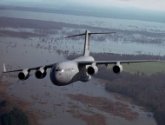
 The C-17 Globemaster III is
the newest, most flexible cargo aircraft to enter the airlift
force. The C-17 is capable of rapid strategic delivery of troops
and all types of cargo to main operating bases or directly to
forward bases in the deployment area. The aircraft is also able
to perform tactical airlift and airdrop missions when required.
The inherent flexibility and performance characteristics of the
C-17 force improve the ability of the total airlift system to
fulfill the worldwide air mobility requirements of the United
States.
The C-17 Globemaster III is
the newest, most flexible cargo aircraft to enter the airlift
force. The C-17 is capable of rapid strategic delivery of troops
and all types of cargo to main operating bases or directly to
forward bases in the deployment area. The aircraft is also able
to perform tactical airlift and airdrop missions when required.
The inherent flexibility and performance characteristics of the
C-17 force improve the ability of the total airlift system to
fulfill the worldwide air mobility requirements of the United
States.
The ultimate measure of airlift effectiveness is the ability
to rapidly project and sustain an effective combat force close
to a potential battle area. Threats to U.S. interests have changed
in recent years, and the size and weight of U.S.-mechanized firepower
and equipment have grown in response to improved capabilities
of potential adversaries. This trend has significantly increased
air mobility requirements, particularly in the area of large
or heavy outsize cargo. As a result, newer and more flexible
airlift aircraft are needed to meet potential armed contingencies,
peacekeeping or humanitarian missions worldwide. The C-17 was
designed and built with this new world order in mind.
Features
The operational requirements impose demanding reliability and
maintainability of the C-17 system. These requirements include
an aircraft mission completion success probability of 92 percent,
only 20 aircraft maintenance manhours per flying hour, and full
and partial mission capable rates of 74.7 and 82.5 percent respectively.
The Boeing warranty assures these figures will be met.
The C-17 measures approximately 174 feet (53 meters) long with
a wingspan of 169 feet, 10 inches (51.76 meters). The aircraft
is powered by four fully reversible Pratt & Whitney F117-PW-100
engines (the commercial version is currently used on the Boeing
757). Each engine is rated at 40,440 pounds of thrust. The thrust
reversers direct the flow of air upward and forward to avoid
ingestion of dust and debris. Maximum use has been made of off-the-shelf
and commercial equipment, including Air Force-standardized avionics.
The aircraft is operated by a crew of three (pilot, copilot and
loadmaster), reducing manpower requirement risk exposure, and
long-term operating costs. Cargo is loaded onto the C-17 through
a large aft door that accommodates military vehicles and palletized
cargo. The C-17 can carry virtually all of the Army's air-transportable
equipment.
Maximum payload capacity of the C-17 is 170,900 pounds (77,519
kilograms), and its maximum gross takeoff weight is 585,000 pounds
(265,352 kilograms). With a payload of 160,000 pounds (72,575
kilograms) and an initial cruise altitude of 28,000 feet (8,534
meters), the C-17 has an unrefueled range of approximately 2,400
nautical miles. Its cruise speed is approximately 450 knots (.74
Mach). The C-17 is designed to airdrop both equipment and 102
paratroopers.
The design of the aircraft lets it operate through small, austere
airfields. The C-17 can take off and land on runways as short
as 3,000 feet (914 meters) and as narrow as 90 feet (27.4 meters)
wide. Even on such narrow runways, the C-17 can turn around using
a three-point star turn and its backing capability.
Background
The C-17 made its maiden flight on Sept. 15, 1991, and the first
production model was delivered to Charleston Air Force Base,
S.C., on June 14, 1993. The 17th Airlift Squadron, the first
squadron of C-17s, was declared operationally ready Jan. 17,
1995. The Air Force is programmed to receive a total of 120 C-17s
by the year 2005. The bulk of the inventory will be at Charleston
AFB and McChord AFB, Wash. C-17s will also be at Altus AFB, Okla.
and an Air National Guard unit at Jackson, Miss.
The aircraft is operated by the Air Mobility Command with current
operations at the 437th Airlift Wing and the 315th Airlift Wing
(Air Force Reserve).
Nation of Orgin: USA
Prime Contractor: Boeing Company
Primary Function: Heavy Transport
Crew: Three
Length: 174ft / 53 meters
Height: 55ft 1 ih / 16.79 meters
Wingspan: 169ft 10in / 51.76 meters
Max t-o weight: 585,000 pounds (265,352 kg)
Engine: Four Pratt & Whitney F117-PW-100 turbofan engines
with 40,440 pounds thrust each
Max speed: 575 mph / Mach 0.87
Service Ceiling: 45,000ft / 13,716 meters